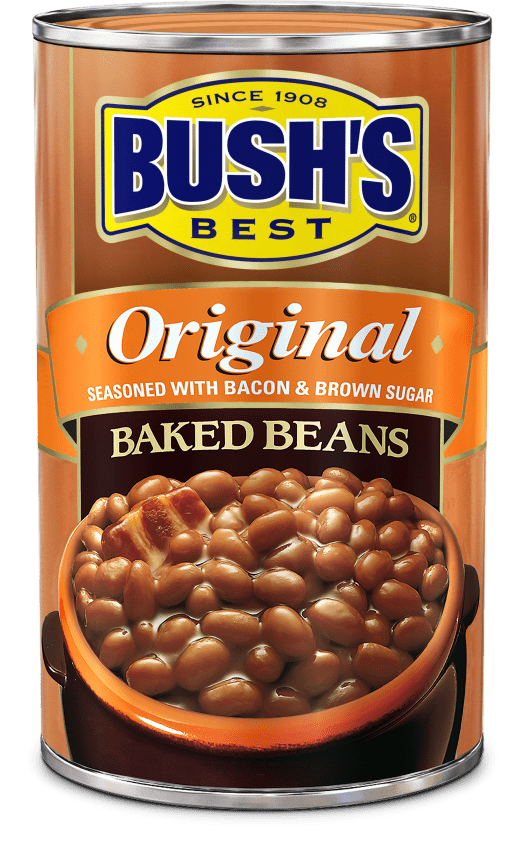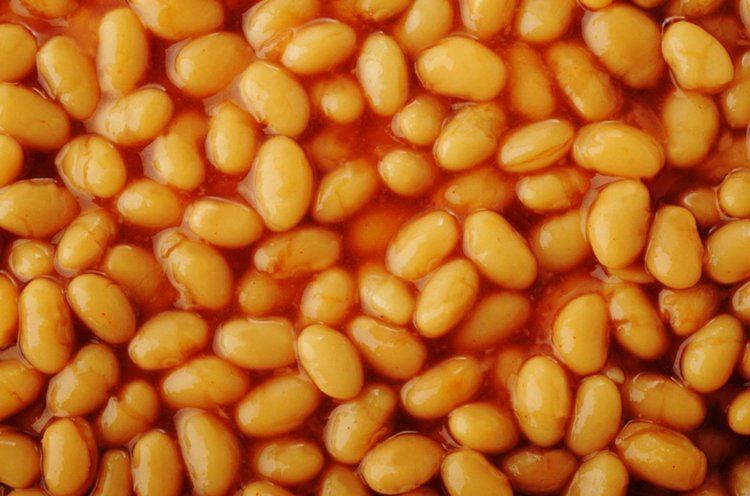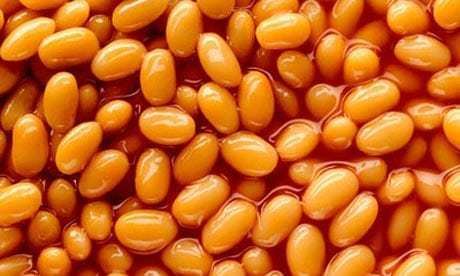 | ||
Similar Bean, Coleslaw, Green bean, Pulled pork, Chili con carne | ||
Baked beans recipe homemade baked beans
Baked beans is a dish containing beans, sometimes baked but, despite the name, usually stewed, in a sauce. Most commercially canned baked beans are made from haricot beans, also known as navy beans – a variety of Phaseolus vulgaris in a sauce. In Ireland and the United Kingdom, a tomato sauce is most commonly used, and they are commonly eaten on toast or as part of a full English, Scottish or Irish Breakfast.
Contents
- Baked beans recipe homemade baked beans
- Homemade spicy baked beans with potato cakes gordon ramsay
- History
- United Kingdom and Ireland
- United States
- Around the world
- Health
- Flatulence
- References

American Boston baked beans use a sauce prepared with molasses and salt pork, the popularity of which has led to the city being nicknamed "Beantown". Beans in a tomato and brown sugar, sugar or corn syrup sauce are a widely available type throughout the U.S. Canada's Quebec-style beans often use maple syrup. This style is also popular in states bordering Canada's Eastern provinces.

Canned baked beans are used as a convenience food. They may be eaten hot or cold straight from the can as they are fully cooked.

Homemade spicy baked beans with potato cakes gordon ramsay
History

The beans presently used to make baked beans are all native to South America and were introduced to Europe around 1528. The dish of baked beans is commonly described as having a savory-sweet flavor and a brownish or reddish tinted white bean once baked, stewed, canned or otherwise cooked. According to alternative traditions, sailors brought cassoulet from the south of France or northern France and the Channel Islands where bean stews were popular. Most probably, a number of regional bean recipes coalesced and cross-fertilised in North America and ultimately gave rise to the baked bean culinary tradition familiar today.

While many recipes today are stewed, traditionally beans were slow baked in a ceramic or cast-iron beanpot. A tradition in Maine, of "bean hole" cooking, may have originated with the native Penobscot people and was later practiced in logging camps. A fire would be made in a stone-lined pit, allowed to burn down to hot coals and then a pot with eleven pounds of seasoned beans would be placed in the ashes, covered over with dirt and left to cook overnight or longer. These beans were a staple of Maine's logging camps, served at every meal.

Canned beans, often with pork, were among the first convenience foods and it is in this form that they became exported and popularised by U.S. companies operating in the UK in the early 20th century. The U.S. Food and Drug Administration stated in 1996 that "It has for years been recognized by consumers generally that the designation 'beans with pork,' or 'pork and beans' is the common or usual name for an article of commerce that contains very little pork." This is typically a piece of salt pork to add fat to the dish.
Canned baked beans with small pork sausages are still available, as are variants with other added ingredients such as chilli.
United Kingdom and Ireland
In the UK, Ireland, Australia, New Zealand, Hong Kong, Brunei, Malaysia and Singapore the term baked beans usually refers to tinned beans in a tomato sauce. They were originally imported from American companies, first sold in the UK in 1886 in the upmarket Fortnum & Mason store in London as an expensive foreign delicacy.
Today, baked beans are a staple convenience food in the UK, often eaten as part of the modern full English breakfast and particularly on toast (called simply 'beans on toast'). Baked beans freshly cooked from raw ingredients, much closer to their original unprocessed, unindustrialised form, are offered by a few upmarket brunch establishments.
The best-selling brand in the UK is Heinz Baked Beans. Heinz also produce baked beans in a gluten-free sauce.
United States
In the United States, Bush's (Bush Brothers and Company), Van Camp's, B&M (Burnham & Morrill Inc.), Allens, Inc., the H. J. Heinz Company, and the Campbell's Soup Company are well-known producers or brands of packaged baked beans. B&M specializes in Boston-style baked beans often sold in beanpot-shaped jars, and canned brown bread, a traditional regional accompaniment to baked beans, whereas Bush and Van Camp produce multiple flavor varieties of canned beans, some styles using cured bacon to flavor the products.
In the New England region, baked beans are flavored either with maple syrup (Northern New England), or with molasses (Boston), and are traditionally cooked with salt pork in a beanpot in a brick oven for six to eight hours. In the absence of a brick oven, the beans were cooked in a beanpot nestled in a bed of embers placed near the outer edges of a hearth, about a foot away from the fire. Today, baked beans can be made in a slow cooker or in a modern oven using a traditional beanpot, Dutch oven, or casserole dish.
In southern states and along the eastern seaboard of the U.S., the beans become tangier usually due to the addition of yellow mustard. For example, the baked beans of Tennessee-based Bush's include mustard in most of their varieties of beans. Ground beef may also become common alongside bacon in the home versions some of these bean styles. They may take on a flavor similar to Cowboy Beans, a home-mixed stew, somewhat similar to a chili but made instead with sweet baked beans.
Baked beans are a staple side dish for various types of barbecue. This is due in part to the ease of handling, as they can be served hot or cold, directly from the can, making them handy for outdoor eating. The tomato-based sweet sauce also complements many types of barbecue. The already-cooked beans may also be baked in a casserole dish topped with slices of raw bacon, which is baked until the bacon is cooked. Additional seasonings are sometimes used, such as additional brown sugar or mustard to make the sauce more tangy.
Heinz baked beans became very successful as an export to the UK, where canned baked beans are now a staple food. In America, the H. J. Heinz Co. continue to sell baked beans, although they are not always as widely distributed as competing American brands. Despite their international fame, there are currently substantial differences between the Heinz baked beans produced for the UK market (descended from the original American recipe) and the nearest currently equivalent American product (Heinz Premium Vegetarian Beans).
The American product contains brown sugar where the British beans do not, and the U.S. product contains 14 g of sugar per 16 oz tin compared to 7 g for the British version (equating to 140 versus 90 calories). The U.S. beans have a mushier texture and are darker in color than their UK counterpart. This has resulted in a situation where the product is now imported back to the brand's home country. For several years, UK Heinz Baked Beans have been available in the U.S., either in different-sized cans from those sold in the UK or in a 385-gram can (the same can as the 415-gram can in the UK) with an "export" label with American English spelling and the word "baked" dropped from the title on the label. These are sold in many U.S. specialty stores, attesting to the popularity of baked beans and their appeal to expats. Bush, Van Camp, B&M, and Heinz all produce pork-free baked beans labeled as vegetarian beans, making this American dish available to people who abstain from pork for religious, dietary, or ethical reasons.
Around the world
Traditional cuisines of many regions claim such recipes as typical specialities, for example:
Many unusual dishes are made with baked beans including the baked bean sandwich. These are slices of bread topped with beans and other additions, such as melted cheese.
Health
In 2002 the British Dietetic Association allowed manufacturers of canned baked beans to advertise the product as contributing to the recommended daily consumption of five – six vegetables per person. This concession was criticised by heart specialists who pointed to the high levels of sugar and salt in the product. However, it has been proven that consumption of baked beans does indeed lower total cholesterol levels and low-density lipoprotein cholesterol, even in normo-cholesterolaemic individuals. Some manufacturers produce a "healthy" version of the product with reduced levels of sugar and salt.
Flatulence
Baked beans are known on occasion to cause a considerable increase in flatulence following consumption; this is due to the fermentation of polysaccharides (specifically oligosaccharides) by gut flora, specifically Methanobrevibacter smithii. The oligosaccharides pass through the small intestine largely unchanged, and when they reach the large intestine, bacteria feast on them, producing copious amounts of flatus. This condition is the basis for the U.S. children's song "Beans, Beans, the Musical Fruit" or, in the UK, "Beans, Beans, Good for the Heart". One of the more prominent examples of the phenomenon, in popular culture, is the campfire scene in Mel Brooks's film Blazing Saddles, in which the cowboys' banter is punctuated by fusillades of flatulence.
